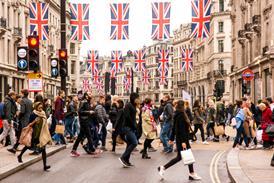Ahead of the return of the Sustainability Summit on October 10, we dig into the strategies of the retailers making tangible progress and glean expert opinion on why the narrative of balancing sustainability with bottom lines “needs to change”
“Frankly, unless we find more sustainable ways of doing business then we do not have a future.”
This is the view of Clare McMahon, Specsavers’ head of sustainability, who is working to “minimise the eyewear retailer’s impact on the planet while maximising its positive impact on communities”.
McMahon is not alone in her opinion as the industry continues to shift gears towards more sustainable, responsible retailing.
In just the past month, All Saints launched a rental service across its entire clothing range to support the circular economy, Holland & Barrett implemented a data platform to enable shoppers to track the origin of products, Seasalt gained B Corp status in recognition of its transparency efforts, and Primark – while often critiqued for its eco credentials – opened pre-loved pop-up shops in its London, Birmingham and Manchester stores.
While some progress has been made, there remains, for several retailers, a concern about the cost of sustainability and how to make the return on investment add up. Orla McGreevy, divisional sales director at centralised data platform LoweConex, believes it to be a troubling issue: “We find all too often the sector looks at sustainability as an overhead or cost without realising the commercial wins a sound strategy can give.”
LoweConex helps retailers observe, analyse and control their buildings and stores remotely at scale. Having worked first-hand with businesses to reduce their emissions, McGreevy says “retailers thinking about sustainability as a cost need to change the narrative internally. Sustainability isn’t a cost – it’s an investment in driving better operations, better business and in securing longstanding profitability that will futureproof your brand.”
So how are retailers using sustainable investments to achieve these goals? We look at some notable retailers making progress in five common ways:
1. Reducing store-based emissions
Be it wasted electricity, heating and cooling, or gas, retailers can generate major energy efficiencies and cost savings by reducing consumption across their store networks aka Scope 2 emissions. Some businesses are already making headway in this regard.
In August, the Midcounties Cooperative announced it was moving to centrally controlled refrigeration, heating and cooling systems at its 230 stores in a bid to further drive down its energy consumption.
The Co-operative partnered with LoweConex on the project, which it expects to reduce its carbon footprint “to the lowest level possible” and help it towards its aim of reducing direct emissions by 50% by January 2026.
Speaking at the time, Julie Sheldon, Midcounties Co-op’s head of energy efficiency, said the group was “committed to using the power of cooperation to build a fairer, more ethical and sustainable future. This partnership is a key part of this, helping us to make continuing progress in reducing our carbon emissions and energy usage, and ensuring our stores operate as efficiently and responsibly as possible.”
For McGreevy, it’s a no-brainer that retailers tackle “rampant” energy wastage and rising costs.
“In the UK, it’s estimated 30% of energy usage is completely wasted, costing the economy billions year-on-year. Retailers not tackling that wastage are not just missing a trick, they’re leaving money on the table and damaging store profitability,” she says.
Specsavers’ McMahon agrees and says “minimising the impact we have on the environment is a key part of our sustainability strategy” for the 1,000+ stores it operates in the UK.
She adds: “We have started installing smart meters in many of our UK stores so we can better understand exactly how we are consuming electricity to inform our decision making. Globally, we have moved 60% of our stores to renewable electricity and will transfer all our stores by 2030.”
2. Empowering staff
Sustainability progress requires all stakeholders to be brought into the journey, not least retail staff.
B&Q and Screwfix parent Kingfisher has invested heavily in making its staff central to its strategy.
The group has hired dedicated energy experts and specialist partners to support customers with sustainability advice and, as shared in its 2023/24 sustainability report published in June, has provided 4,000 hours of staff training to enable colleagues to host practical courses for customers.
Overseas, colleagues at its Castorama France and Brico Dépôt France fascias have introduced an interactive, educational way of accelerating understanding of climate change. ‘Fresque du Climat’ – a neutral and objective tool, based on scientific data – asks workshop participants to link cause and effect and take a global view of climate issues. La Fresque engages people in constructive exchanges, leaving them motivated and better equipped to take action. As of January 2024, 10 colleagues at Castorama and Brico Dépôt have been trained to run these workshops and 14 workshops have been held since July 2023. More than 280 colleagues have taken part.
Meanwhile, in the UK, in 2023 more than 3,700 Screwfix colleagues took part in ‘The Big Switch!’ – a campaign making a commitment to make switches at work and home to reduce their carbon footprint. Each time a team member made a switch, such as cycling to work rather than driving, or switching to paperless billing, they ticked it off on a master list. Kingfisher then added these up to show the collective power of its teams. Following the campaign, the sustainability question included in Screwfix’s annual staff survey became the most improved question – up 16 (net promoter) points from the previous year.
3. Leading change with suppliers
Pets at Home, winner of the Retail Week Responsible Retailer of the Year Award in 2023, publishes a sustainability report every year to make its progress known. Supplier engagement and collaboration is a central priority for the petware business’ sustainability focus and in its June 2023 report, it revealed it had set a new target to hold its suppliers accountable.
This target requires that, by 2028, all priority suppliers must have carbon reduction plans in place and 50% must have achieved leadership category (meaning that they have a science-based or net-zero strategy). Pets at Home had already been working with its suppliers on their Scope 1 and 2 reductions as part of its supply chain strategy and its report stated that it is “our expectation that all our suppliers actively manage their operational carbon impact”.
“We recognise that we have suppliers at different stages of their journey, so we have developed a carbon maturity framework that guides them on how to measure, manage and share their carbon performance. Suppliers have been directed to our ‘Knowledge Hub’ that lays out our expectations and shares information about carbon management,” the business says.
Specsavers’ McMahon is focused on making similar progress with the eyewear retailer’s supplier base.
“As with many businesses, the vast majority of our carbon footprint is produced within our supply chain, especially in our products. We are working with our frame suppliers to move away from virgin fossil fuel-based materials wherever possible. Sourcing recycled and bio-based material alternatives for our frames enables us to offer our customers products that offer all the style and performance benefits they are used to, while using less of the resources our planet is running low on”, she explains.
4. Implementing eco-innovations
From eco materials to tech-enabled product design and game-changing supply chain solutions, a flurry of innovations has hit the market to enable retailers to become more sustainable. This includes digital product passports (DPPs).
In September 2023, fashion retailer Nobody’s Child and data and tech company Fabacus launched the first DPPs. Vastly innovative for their potential to support supply chain traceability, DPPs feature QR codes on product care labels which consumers can scan for information about raw materials, suppliers, logistics, packaging, care instructions, use and more. The strategic implication of this tech is two-fold; it enables shoppers to make more informed decisions about their purchases and helps retailers better track their carbon footprint and work more closely with suppliers.
In August 2024, Tesco followed suit and introduced DPPs for its F&F clothing brand with every item from its range featuring the tool. Tesco head of technical Joe Little said: “Digital product passports represent an important step forward, encouraging and promoting sustainable and circular practices.”
It comes as DPPs are being introduced across the EU, endorsed by the European Commission, to improve sustainability. Industrial and electric vehicle batteries will be the first products to have mandatory DPPs, from 2027. Other product categories, including textiles, are expected to follow by 2030.
5. Charging ahead with EVs
While electric vehicle (EV) charging infrastructure is still a relatively new concept, several retailers are transitioning to this alternative fuel for their fleets to reduce their carbon footprint.
Ikea is one such example. The homewares giant has worked with Mer UK, the EV charging specialist, to switch its fleets, as it looks to achieve its target of net-zero emissions by 2025. As part of its £4.5m EV investment, announced in April last year, the pair are working together to deliver almost 200 chargers which will provide charging points for new electric vehicles owned by Ikea.
Mer UK head of sales Natasha Fry says having a “collaborative, adaptable approach allowed us to help Ikea align its infrastructure with its ambitious environmental goals”.
“Electric mobility is one of the most effective ways to reduce carbon emissions. While not all vehicles can be immediately replaced by electric alternatives—especially when considering factors like payload, capacity, and range for logistics fleets—manufacturers are increasingly focusing on developing vehicles that are fit for purpose. By investing in electric vehicles and charging infrastructure now, retailers can scale their transition at a pace that suits their operations”, adds Fry.
Retailers have been making big strides in EV charging for consumers and not just fleets too. Tesco, for instance, continues to host the UK’s biggest supermarket charging network, with 1,305 devices now in place for shoppers.











































No comments yet